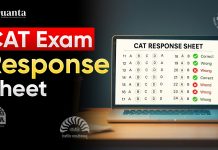Most of the aspirants are nowadays scared of LRDI, the reason being the level of LRDI in CAT exam. Before 2015, LRDI sets were easy to moderate and then over the years the difficulty level increased. But what if there are again Easy to Moderate sets in 2025? We can’t guess anything for sure, So for CAT 2025, don’t go with a preconceived notion that LRDI is going to be very tough or easy. Expect the unexpected when you are preparing for CAT.
One of the iQuanta LRDI associate (100%ler in LRDI) had penned down few strategies and shared with me last year.
Logical Reasoning & Data Interpretation : LRDI Course Structure & CAT LRDI Syllabus
So a student following iQuanta CAT Course Structure | For any topic should take 1, Application Class, 1 Conceptual Class, take an assignment available on Dashboard, participate in Daily LRDI initiative and then can do self study from IIM ABC Practice Batch. Then move to next topic classes in the same manner.
In previous CAT Exams (Data Interpretation & Logical Reasoning), there were 4 sets (2 in data and 2 in reasoning) that were very easy just that they were time taking, and almost same has been the scenario every year since then. The point here is that most of the aspirants sit in the examination hall with a mind-set to solve all the questions i.e. for one question you would get nearly 1min 50 sec and then under this time constraint, you may screw up even the easy questions. Before exam, you must clearly evaluate your own speed and accuracy and then should come up with an effective game plan. Now what an unprepared aspirant did was, he planned to attempt 27 questions in 1 hour which gave him around 7 sets and each set got more than 9 minutes. Now this is what he planned to attempt despite having thoroughly prepared for the section. So never plan or stick to a strategy you can’t afford to.
In order to score well, evaluate where you stand and take exams with strategies that are suitable for YOUR strengths and weakness. If you feel that you are not doing well in DILR then first focus should be on your ACCURACY, don’t bother about speed at all at this point. Speed will eventually catch up if you keep practicing on a daily basis. The most important aspect to ace Data Interpretation & Logical Reasoning is the accuracy and smoothness with which you solve a given problem. CAT exam is to be treated as a 2-hour marathon and not as a sprint. When CAT LRDI 100%ler started his CAT exam preparation, Data Interpretation & Logical Reasoning was the most hated section for him. So he had to practise religiously in this section and almost neglected Quant section, which was his favourite. Even after the exam he hoped to be a 100%iler in Quant and expected about 95%ile in Data Interpretation & Logical Reasoning. It was after the results were announced that he realized how accuracy affects our scores. As a matter of fact, now his favourite is Data Interpretation & Logical Reasoning.
Many aspirants consider Logical Reasoning as the toughest part in CAT examination. Logical Reasoning questions usually come with 2/3 bits. A paragraph is given with full of information followed by 2/3 questions. You have to read the information thoroughly and apply your logic for answering these questions. The first and most important step in solving an LR problem is to write down all of the information given in a box, table or diagram. For example, if the problem involves seating arrangements at a round table, always draw the table first and then try various permutations and combinations of people seated around it. Once you have drawn the figure for the problem, you are free to think with a clear mind. LR problems usually contain several statements which serve as clues to solving the given questions. Thus, the problem should always be attempted in a methodical manner, and solved step-by-step, because trying to look at all the information at once will confuse even the best of us.
CAT Logical Reasoning problems are usually ‘all-or-nothing’ type, in the sense that if you crack the crux of the problem then you will be able to answer all/most of the questions that follow; and if you don’t, you will not be able to answer even a single question. This is because if the logic behind the problem is known to you, the questions that follow can get solved easily. Hence, proper selection of problems to solve first is even more crucial here than in Data Interpretation. Often, students fail to solve a problem after investing 10-15 minutes on it. Since the information they have at the end of that time is not much more than that at the beginning, they cannot answer even a single question in the set and have nothing to show for their effort. Problem-selection is tricky, so if you find that you are unable to solve it after the first 5 minutes, do the smart thing and switch to another set of the section. Although, you should be very wise in your decision of leaving the question as you can always come back later on the question if you have the time but once you switch the section, you can’t come back to it again. Therefore, for each aspirant, to Attempt or not to attempt is the main question.
Enroll for iQuanta CAT 2025 Course
To be honest the best thing one has to do is to solve the maximum variety of sets, enough so as you are able to guess which set is doable for you and which set is not, that’s it. In iQuanta mocks and sectionals, there are around 240 CAT level LRDI sets overall and if one solves them all properly then they are almost through this section. Now what do I mean by properly solving? Let’s see..

Following are 10 Tips to ace Logical Reasoning
1. Invest some time over a question and study the question carefully before you start solving. A brief explanation of why each choice is correct or incorrect should go into your mind. If you can practice this tip in sample reasoning questions, you will do well on the actual assessment.
2. NEVER assume or use any information that the question fails to give you. This is NOT an assessment of how much you know about a subject in general! Consider ONLY the information given in each reading passage when choosing among the alternative responses.
3. Read both the factual passage and the sentence completion instructions carefully. Both must be considered in making your choice.
4. Be sure to read all the response choices carefully before eliminating or choosing one of them.
5. In questions that ask you to select a valid conclusion, always choose the one conclusion that definitely follows from the information you are given. In questions that ask you to find the invalid alternative, choose the one conclusion that does not definitely follow from the information.
6. Pay special attention to words like “all,” “some,” or “none” when you read the factual information. Other qualifying words such as “other than,” “only” or “unless” are important too. These words can play a critical part in precisely specifying the facts to be used in your reasoning.
7. Pay attention to negative prefixes also, such as non-, un-, or dis-. These can be crucial to specifying the basic facts in the paragraph.
8. You should also be very careful if any response choices that contain the quantifiers “all” or “none”. Generally, in both the sample practice questions and in the actual CAT assessment, these words are NOT signs of incorrect response choices. They will appear in both correct and incorrect response choices.
9. Pay close attention to the word “ONLY” and to the phrase “IF AND ONLY IF”. Saying “The car lock will open IF AND ONLY IF original keys are used” sets up a highly specific condition that must be met. There is exactly one way to open the car lock – you must use the original keys of the car. By contrast, if the sentence says, “The car lock will open if the original key is used,” there may be several ways to open the car lock besides by using the original key.
10. The questions in the assessment will vary in difficulty level, and difficult questions will be mixed in with easier ones throughout the CAT exam Paper. When you encounter a question that is difficult for you, then you should try to draw diagrams or other schematic notes on your “scratch” paper, which are provided to support and confirm your thought processes. Also, bear in mind that you can stop working on a difficult question temporarily and return to it later but it could be done only if you have not changed the section.
Join the Largest CAT Preparation Community in India

Almost everyone asked me from where they should practice DILR questions. My answer is there is no specific book for Data Interpretation & Logical Reasoning. You can study the basics from any coaching institute material. And then get into old CAT exam questions. While you do a question from somewhere please do ensure to study all dimensions of the questions. Make your own conclusions. And try to do a timed sectional mock at least once in a week. And a full mock test at least once in two weeks. From my experience, learning from taking/analysing mocks is very important.
Enroll for iQuanta CAT 2025 Course







